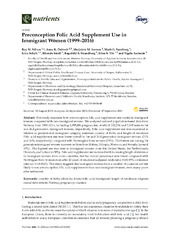| dc.contributor.author | Nilsen, Roy Miodini | en_US |
| dc.contributor.author | Daltveit, Anne Kjersti | en_US |
| dc.contributor.author | Iversen, Marjolein M. | en_US |
| dc.contributor.author | Sandberg, Marit G. | en_US |
| dc.contributor.author | Schytt, Erica | en_US |
| dc.contributor.author | Small, Rhonda | en_US |
| dc.contributor.author | Strandberg, Ragnhild Bjarkøy | en_US |
| dc.contributor.author | Vik, Eline Skirnisdottir | en_US |
| dc.contributor.author | Aasheim, Vigdis | en_US |
| dc.date.accessioned | 2020-05-13T12:48:40Z | |
| dc.date.available | 2020-05-13T12:48:40Z | |
| dc.date.issued | 2019-09-27 | |
| dc.Published | Nilsen RM, Daltveit AK, Iversen M.M., Sandberg, Schytt E, Small R, Strandberg RØ, Vik ES, Aasheim V. Preconception folic acid supplement use in immigrant women (1999-2016). Nutrients. 2019;11:2300(10) | eng |
| dc.identifier.issn | 2072-6643 | |
| dc.identifier.uri | https://hdl.handle.net/1956/22237 | |
| dc.description.abstract | This study examines how preconception folic acid supplement use varied in immigrant women compared with non-immigrant women. We analyzed national population-based data from Norway from 1999–2016, including 1,055,886 pregnancies, of which 202,234 and 7,965 were to 1st and 2nd generation immigrant women, respectively. Folic acid supplement use was examined in relation to generational immigrant category, maternal country of birth, and length of residence. Folic acid supplement use was lower overall in 1st and 2nd generation immigrant women (21% and 26%, respectively) compared with Norwegian-born women (29%). The lowest use among 1st generation immigrant women was seen in those from Eritrea, Ethiopia, Morocco, and Somalia (around 10%). The highest use was seen in immigrant women from the United States, the Netherlands, Denmark, and Iceland (>30%). Folic acid supplement use increased with increasing length of residence in immigrant women from most countries, but the overall prevalence was lower compared with Norwegian-born women even after 20 years of residence (adjusted odds ratio: 0.63; 95% confidence interval: 0.60–0.67). This study suggests that immigrant women from a number of countries are less likely to use preconception folic acid supplements than non-immigrant women, even many years after settlement. | en_US |
| dc.language.iso | eng | eng |
| dc.publisher | MDPI | eng |
| dc.rights | Attribution CC BY | eng |
| dc.rights.uri | http://creativecommons.org/licenses/by/4.0/ | eng |
| dc.title | Preconception folic acid supplement use in immigrant women (1999-2016) | en_US |
| dc.type | Peer reviewed | |
| dc.type | Journal article | |
| dc.date.updated | 2019-10-29T07:43:50Z | |
| dc.description.version | publishedVersion | en_US |
| dc.rights.holder | Copyright 2019 The Author(s) | |
| dc.identifier.doi | https://doi.org/10.3390/nu11102300 | |
| dc.identifier.cristin | 1740907 | |
| dc.source.journal | Nutrients | |

